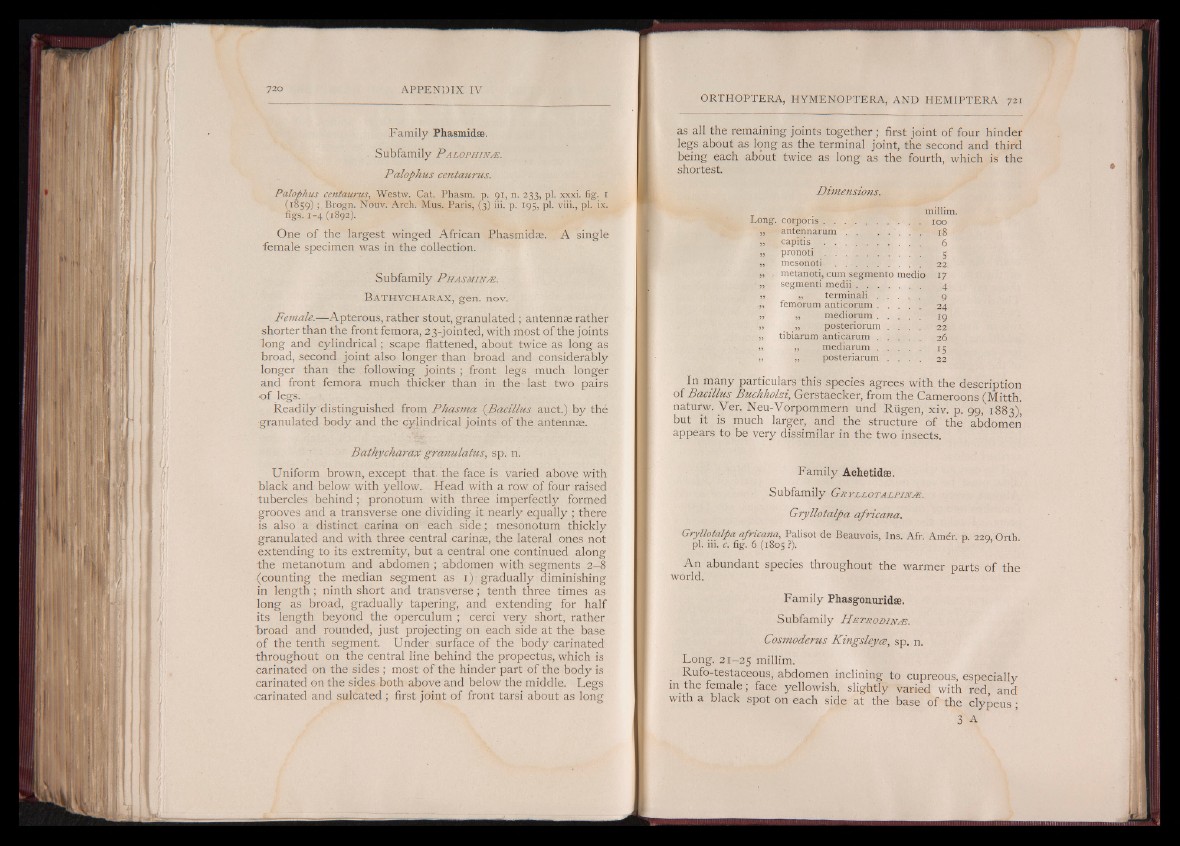
Family Phasmidæ.
. Subfamily P a l o p h i n æ .
Palophus centaurus.
Palophus centaurus, Westw. Cat. Phasm. p. 91, n. 233, pi. xxxi. fig. 1
(1859) ; Brogn. Nouv. Arch. Mus. Paris, (3) iii. p. 195, pi. viii., pi. ix.
figs. 1-4 (1892).
One of the largest winged African Phasmidæ. A single
female specimen was in the collection.
Subfamily P h a s m i n æ .
Bathycharax, gen. nov.
Female.-—Apterous, rather stout, granulated ; antennae rather
shorter than the front femora, 23-jointed, with most of the joints
long and cylindrical ; scape flattened, about twice as long as
broad, second joint also longer than broad and considerably
longer than the following joints ; front legs much longer
and front femora much thicker than in the last two pairs
■of legs.
Readily distinguished from Phasma (Bacillus auct.) by thé
granulated body and the cylindrical joints of the antennae.
Bathycharax granulatus, sp. n.
Uniform brown, except that, the face is varied above with
black and below with yellow. Head with a row of four raised
tubercles behind ; pronotum with three imperfectly formed
grooves and a transverse one dividing it nearly equally ; there
is also a distinct carina on each side ; mesonotum thickly
granulated and with three central carinæ, the lateral ones not
extending to its extremity, but a central one continued along
the metanotum and abdomen ; abdomen with segments 2-8
(counting the median segment as i)- gradually diminishing
in length ; ninth short and transverse ; tenth three times as
long as broad, gradually tapering, and extending for half
its length beyond the operculum ; cerci very short, rather
"broad and rounded, just projecting on each side at the base
of the tenth segment. Under surface of the body carinated
throughout on the central line behind the propectus, which is
carinated on the sides ; most of the hinder part of the body is
carinated on the sides both above and below the middle. Leers
carinated and sulcated ; first joint of front tarsi about as long
ORTHOPTERA, HYMENOPTERA, AND HEMIPTERA 721
as all the remaining joints together ; first joint of four hinder
legs about as long as the terminal joint, the second and third
being each about twice as long as the fourth, which is the
shortest.
Long.
Dimensions.
millim.
corporis .........................100
antennarum . . . . . . .
c a p i t i s ....................................;
p r o n o t i................ ....................
m e s o n o t i ................................
metanoti, cum segmento medio
segmenti medii........................
„ terminali . . . . .
femorum anticorum................
18
6S
22
17
4
9
24
mediorum................ 19
„ posteriórum
tibiarum anticarum .
22
26
„ mediarum................. 15
„ posteriarum . . . . 22
In many particulars this species agrees with the description
of Bacillus Buchholzi, Gerstaecker, from the Cameroons (Mitth.
naturw. Ver. Neu-Vorpommern und Rügen, xiv. p. 99, 1883),
but it is much larger, and the structure of the abdomen
appears to be very dissimilar in the two insects.
Family Achetidae.
Subfamily G r y l l o t a l p i n p e .
Gryllotalpa africana.
Gryllotalpa africana, Palisot de Beauvois, Ins. Afr. Amdr. d 220 Onb
pi. iii. c. fig. 6 (1805 ?).
An abundant species throughout the warmer parts of the
world.
Family Phasgonuridae.
Subfamily H e t r o d i n m .
Cosmoderus Kingsleyce, sp. n.
Long. 21-25 millim.
Rufo-testaceous, abdomen inclining to cupreous, especially
in the female; face yellowish, slightly varied with red, and
with a black spot on each side at the base of the clypeus ;
3 A